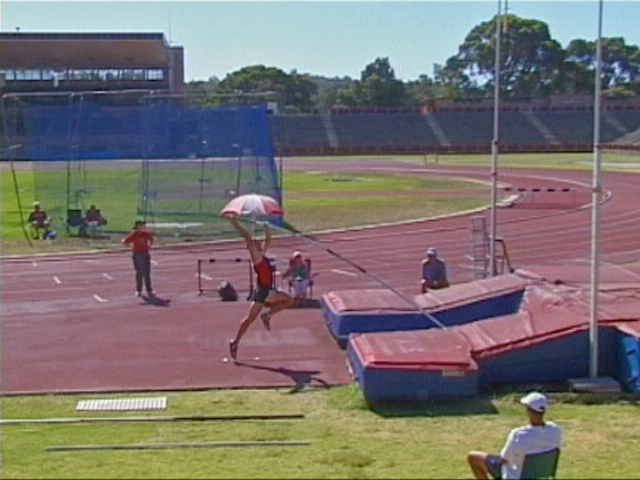I will try to get a single image of Paul posted to illustrate the point that he was not a drive vaulter -that he was striving for a free take off - that he was trying to take off up through the pole - perhaps the single most important and obvious element in the Petrov model. Single images 'like one of video clips can be deceptive but this is from a 5.91 jump -a pr - so one would think he was jumping the way he wanted to jump.
This is a complex area because you can watch one clip after another of Bubka and THEY all look different to some degree of or other . Why is this. Well even gymnasts and divers who do not have to run forty metres carrying a long pole before they do their thing - often get it wrong. Sometimes completely wrong as you have no doubt seen,
The vaulter has a much more difficult challenge to replicate a specific movement pattern. Minute variations in the run up/balance/control /SPEED and Take off point all feed into the movement pattern for good or ill. Since everything that follows the take off is to some degree or other determined by that take off, it means that successive elements will vary as well. Consider what Bubka said when i asked him about what I had termed a pre jump. he said you are absolutely right - I always tried to pre jump - that is leave the ground before the pole tip hit the back of the box -and i managed it a few times in my career!
Many vaulters tuck and shoot simply because they have been unable to put sufficient energy into the vaulter pole system at take off or in the second phase to continue to swing long and instead are forced to tuck to increase the speed of their rotation -unfortunately and this was something you did not mention in your original piece - this rotation almost invariably leaves them UNDER the pole and often 30 cms or more further from the bar than athletes who do swing long to cover the pole.
So even a petrov vaulter who makes slight errors in any or all of the run /plant/ take off/ has to deal intuitively with the situation they find themselves in as they swing past the chord of the pole - and make intuitive adjustments accordingly. This is why you will see variations from one jump to the next in the same athlete in the same comp.
When you bring a different athlete into the picture then the differences between them and someone else using the same model get magnified. Compare Bubka with Gibilisco -both coached by petrov from the beginning of their careers but with significant differences. But they were both trying to exploit the same model. And that is really the issue -how were they trying to jump -what were they trying to do. So if you look for common elements you will see an attempt to execute a specific approach to carrying the pole, to running technique/ to lowering the pole/ to planting the pole / the free take off / the long whip swing of the take leg after a completely finished take off up and through the pole etc - when you know the model you can recognise it -even with a left hander like Annika Becker!
Another critical factor in all this is the coach. There is only one petrov. The rest of do the best we can in the context in which we find ourselves - and with the athletes we have. As I state repeatedly - and probably for the last time on this forum - ordinary athletes who manage to master SOME elements of the petrov model will jump higher because of it.
Finally Paul was coached from the beginning by one of the best young coaches in the world, Steve Rippon -presently in England working with, among others, Steve Lewis who jumped 5.65 earlier this year; Steve took on Petrovs ideas but his athlete model was Rodion Gataullin - not Bubka - so naturally there were going to be variations on a theme.
In the end you must understand the critical elements of the petrov model -and then you will see them - or at least some of them - perhaps in bastardised form - in any athlete trying to use it.
I think this is as much as I can contribute to this debate. No matter what I do or say the barbs come flying in - even from whippersnappers who may have vaulted higher than me but who have coached no one and who certainly are not as good a soccer player as I was!
I put my shingle up with BTB and i think it is time to leave it at that - at least until a second edition appears. Good luck with your search.



